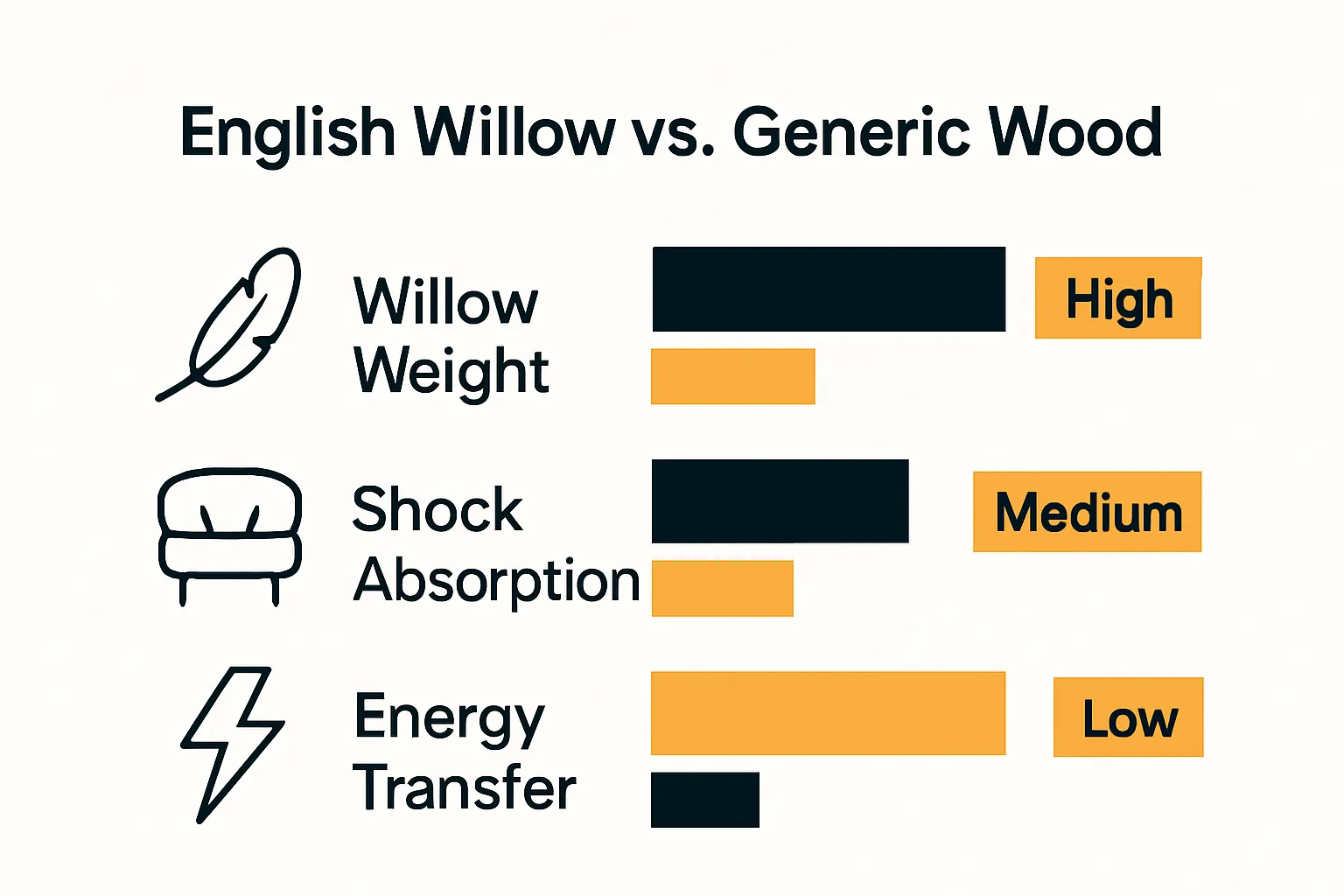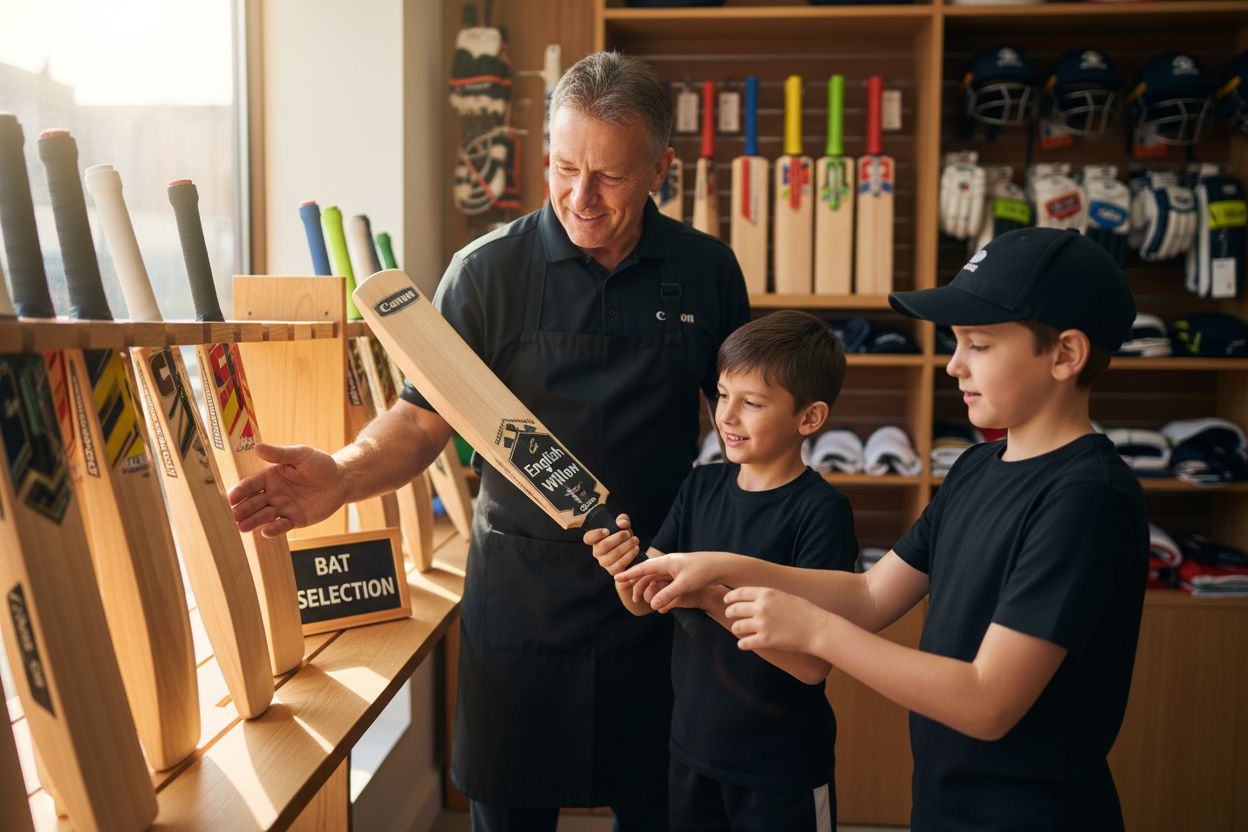What is a Cricket Bat? Understanding Its Importance and Design

A cricket bat is not just a stick with a flat face and a handle. Did you know the average cricket bat weighs between 2.7 and 3 pounds and is carefully crafted from willow chosen for shock absorption and resilience? Most people think any wooden bat can do the job. In reality, even slight differences in its structure and materials can make or break a player’s performance on the pitch.
Table of Contents
- Defining A Cricket Bat: Structure And Materials
- The Importance Of A Cricket Bat In The Game
- How A Cricket Bat Affects Performance
- Key Features To Consider When Choosing A Cricket Bat
Quick Summary
| Takeaway | Explanation |
|---|---|
| Cricket bats are engineered for performance | A cricket bat’s design optimizes ball contact, energy transfer, and player comfort. |
| Material affects performance characteristics significantly | English willow remains the top choice for its shock absorption, weight, and durability. |
| Weight and balance impact swing speed | The selected bat’s weight must match player strength for optimal performance and control. |
| Personal compatibility is crucial for bat selection | Individual playing style and batting position should guide bat choice for best results. |
| Understanding bat dynamics enhances player confidence | Familiarity with a bat’s features can lead to improved shot execution and game strategy. |
Defining a Cricket Bat: Structure and Materials
A cricket bat represents a carefully engineered sporting tool designed specifically for striking a cricket ball with precision and power. Unlike ordinary sporting equipment, a cricket bat requires intricate design considerations that balance performance, durability, and player comfort.
The Essential Anatomy of a Cricket Bat
Every cricket bat comprises two primary sections: the blade and the handle. The blade’s unique design features a flat striking surface and a curved back, crafted to optimize ball contact and energy transfer. The blade is typically constructed from willow wood, specifically English willow, prized for its exceptional combination of lightweight structure and remarkable shock absorption capabilities.
The handle, usually made from cane or composite materials, connects to the blade through a critical component called the splice. This connection point must withstand significant dynamic forces during batting, requiring extraordinary structural integrity. The handle’s design incorporates strategic engineering to minimize vibration and provide players with optimal grip and control.
To help readers quickly compare the roles and features of the main components, the following table outlines the essential anatomy of a cricket bat and the purpose of each part.
| Component | Description | Role in Performance |
|---|---|---|
| Blade | Flat front and curved back, usually made of English willow | Main striking surface; transfers energy |
| Handle | Made from cane or composite materials; connected by splice | Minimizes vibration; provides grip |
| Splice | Junction connecting blade and handle | Maintains bat structure under impact |
| Grip | Rubber or textured material wrapped around handle | Ensures control; reduces hand slippage |
| Sweet Spot | Optimal impact area on the blade | Maximizes power and shock absorption |
Material Selection and Performance Characteristics
Material selection plays a crucial role in determining a cricket bat’s performance. English willow remains the gold standard, offering several unique properties:

- Superior lightweight characteristics
- Exceptional shock absorption capabilities
- Natural resilience to repeated ball impacts
- Ability to maintain structural integrity under high-stress conditions
Modern cricket bat manufacturing has evolved to include advanced techniques like computer-aided design and precise wood selection. Our comprehensive guide on cricket bat selection provides deeper insights into understanding these nuanced material considerations.
The bat’s overall weight, typically ranging between 2.7 and 3 pounds, directly influences a player’s swing speed and control. Professional players often prefer bats with specific weight distributions that match their individual playing styles, demonstrating how seemingly simple equipment involves complex engineering principles.
Understanding the intricate structure and materials of a cricket bat reveals it is far more than a simple wooden implement. It represents a sophisticated piece of sporting technology designed to transform a player’s skill and technique into precise, powerful ball strikes.
The Importance of a Cricket Bat in the Game
A cricket bat represents more than just a piece of sporting equipment. It is the primary instrument through which a player transforms skill, technique, and strategy into tangible runs and match-winning performances. According to the International Cricket Council, the bat serves as a critical interface between player performance and game dynamics.
Strategic Significance in Cricket Gameplay
In cricket, the bat is not merely a tool but a strategic extension of the player’s physical capabilities. Its design and the player’s mastery directly influence the team’s scoring potential. Professional players understand that a well-selected bat can significantly enhance batting performance, enabling precise shot selection, improved ball control, and increased power generation.
The bat’s importance extends beyond simple ball striking. It represents a player’s primary defensive mechanism, allowing batters to protect their wicket while simultaneously creating opportunities to score runs. Professional cricketers invest considerable time in selecting and understanding their bat’s unique characteristics, recognizing that equipment can profoundly impact match outcomes.
Performance Metrics and Player Capabilities
Cricket bats contribute to performance through several critical metrics:
- Shot precision and control
- Power generation during ball strikes
- Defensive capabilities against fast bowling
- Energy transfer from bat to ball
- Psychological confidence for the player
The weight, balance, and construction of the bat directly influence a player’s ability to execute complex shots. A bat that complements a player’s physical attributes and playing style can transform an average performance into an extraordinary one. Our essential cricket equipment guide provides deeper insights into understanding these nuanced performance considerations.
Professional players often develop almost symbiotic relationships with their bats, treating them as personalized instruments tuned to their specific playing techniques. This connection underscores the bat’s profound importance beyond its physical structure, representing a critical link between individual skill and collective team performance in the complex world of cricket.
How a Cricket Bat Affects Performance
A cricket bat is not simply an accessory but a sophisticated instrument that critically influences a player’s batting performance. Scientific research on bat dynamics reveals complex interactions between bat characteristics and player capabilities that determine scoring potential and shot effectiveness.
Weight and Balance Dynamics
The bat’s weight and balance represent fundamental performance factors that directly impact a player’s ability to generate power and control. Professional cricketers meticulously select bats that complement their physical attributes and playing style. A bat that is too heavy can slow down swing speed and reduce shot precision, while an excessively light bat might compromise power generation.
Critical weight considerations include:
- Total bat weight
- Weight distribution along the blade
- Relationship between bat weight and player’s physical strength
- Impact on swing speed and reaction time
- Potential energy transfer during ball strike
Technical Performance Metrics
Bat performance extends beyond simple weight measurements. The sweet spot location, handle flexibility, and blade composition collectively determine a bat’s efficiency. Explore our comprehensive guide on bat performance metrics to understand these nuanced technical considerations.
Professional players develop an almost intuitive understanding of their bat’s capabilities. The bat becomes an extension of the player’s technique, transforming raw physical potential into precise, powerful shot execution. Factors like blade stiffness, handle shock absorption, and grain alignment contribute to a bat’s ability to transfer maximum energy during ball contact.
Ultimately, a cricket bat’s performance is a delicate balance between engineering precision and individual player skill. The right bat can elevate a player’s performance, turning potential into remarkable sporting achievement.
Key Features to Consider When Choosing a Cricket Bat
Selecting the right cricket bat is a nuanced process that requires understanding multiple performance factors. According to expert equipment analysis, choosing a cricket bat involves considering several critical characteristics that directly impact player performance and comfort.
Structural and Material Considerations
The fundamental aspects of bat selection revolve around understanding the intricate relationship between material quality, structural design, and individual player requirements. English willow remains the premier wood choice, with different grades offering varying performance characteristics. Players must evaluate factors such as wood grain, moisture content, and overall blade consistency.
Key structural elements that demand careful evaluation include:
- Blade thickness and profile
- Handle flexibility and shock absorption
- Weight distribution along the bat
- Grain quality and uniformity
- Surface smoothness and finish
Performance and Personal Compatibility
Beyond technical specifications, a cricket bat must align with a player’s unique physical attributes and playing style. Our comprehensive bat selection guide provides deeper insights into matching bat characteristics with individual player needs.
Professional cricketers understand that bat selection transcends generic specifications. Factors like batting position, preferred shot repertoire, and individual strength significantly influence the ideal bat choice. A middle-order aggressive batsman might prioritize different bat characteristics compared to an opening batsman or a defensive player.
The perfect cricket bat represents a harmonious blend of technical excellence and personal comfort.
The following table summarizes key features to consider when choosing a cricket bat, providing a concise comparison of how each factor affects bat selection and overall player performance.
| Feature | Why It Matters | Impact on Performance |
|---|---|---|
| Blade Thickness | Affects power generation and shot control | Thicker blades offer more power |
| Handle Flexibility | Influences shock absorption and comfort | Flexible handles reduce vibration |
| Weight Distribution | Alters swing speed and maneuverability | Balanced bats improve control |
| Grain Quality & Uniformity | Indicates wood quality and durability | Better grains yield longer lifespan |
| Bat Weight | Must match player strength and style | Right weight prevents fatigue |
| Surface Finish | Affects aesthetics and smoothness | High finish can reduce moisture damage |
| While objective measurements provide crucial guidance, the ultimate test remains the player’s intuitive connection with their chosen instrument. A bat that feels like a natural extension of the player’s technique can transform potential into extraordinary sporting performance. |

Take Your Cricket Experience Further with the Right Bat
Are you struggling to choose a cricket bat that matches your skill and playing style? As highlighted in our article, the design, structure, and materials of a cricket bat make a major difference in your performance on the field. Finding a bat with the right balance, sweet spot, and weight can be overwhelming, especially when you’re searching for a solution that feels like a true extension of yourself.

At CricketKingdom.co.uk, you can discover a broad selection of expertly crafted cricket bats and equipment tailored for every level of player. Our professional-grade willows, customized services like free batting oiling and knocking for high-value bats, and convenient checkout options make it easy to upgrade your gear today. Still unsure which features matter most or how to match a bat to your exact needs? Explore our Ultimate Guide to Choosing the Right Cricket Bat to get clear, practical advice. Your future on the field is shaped by the equipment you trust. Shop with confidence now at CricketKingdom.co.uk and experience the difference the right bat can make.
Frequently Asked Questions
What is the main structure of a cricket bat?
A cricket bat consists of two primary sections: the blade and the handle. The blade features a flat striking surface and a curved back, while the handle connects to the blade through a component called the splice.
What materials are used to make a cricket bat?
The most common material for cricket bats is English willow, known for its lightweight structure and exceptional shock-absorbing capabilities. Handles are typically made from cane or composite materials.
How does a cricket bat affect a player’s performance?
A cricket bat influences a player’s performance through factors such as weight, balance, and sweet spot location. These characteristics can impact shot precision, power generation, and overall control during batting.
What key features should I consider when choosing a cricket bat?
When selecting a cricket bat, consider factors like blade thickness, handle flexibility, weight distribution, and the quality of the wood grain. Additionally, it’s important to match the bat’s characteristics with your individual playing style and physical attributes.
Recommended
- The Evolution of Cricket Bat Designs | The Cricket Kingdom
- Ultimate Guide to Choosing the Right Cricket Bat | the Cricket Kingdom
- How to Choose Cricket Bat: A Step-by-Step Guide for Players – The Cricket Kingdom
- The Science of Sensor-Equipped Cricket Bats | The Cricket Kingdom


